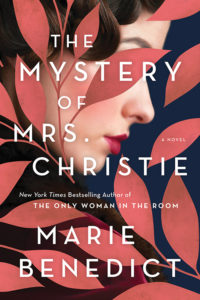
The Mystery of Mrs. Christie
by Marie Benedict
historical fiction
Sourcebooks Landmark – December 2020
The Mystery of Mrs. Christie. Try saying that five times fast.
As any of my lovely coworkers at Pipeline will tell you, I’m incredibly partial to any material—whether it be in film, TV, theater, or literature—that’s historical. Ask me about any period drama that’s been released in the past ten years in those mediums, and there’s not only a very high chance that I have seen or read it, but also that I have a very strong opinion about its merits.
For example, I’ll fight anyone who suggests Mad Men isn’t a perfectly crafted dissection of the fallacies and contradictions of the American dream, gender identity, and societal hierarchy, or that The Knick isn’t the most underrated series of the past century.
I’m kidding. Kind of.
On the flip side of being such an aficionado, however, comes a b***s*** meter that runs deeper than a submarine. Growing up as the son of a New York Times best-selling historical fiction novelist, I can sniff out creatives who haven’t done their homework on the era they’ve set their pieces in from a mile off. In that sense, historical fiction is probably the hardest genre to execute from a writing perspective. Not only do you have to have razor-sharp plots and character development, but you also need to authentically capture the essence of your time period. And if you nail the former but not the latter? Your work isn’t worth the weight of the two pennies you found in the back of your sock drawer.
Enter The Mystery of Mrs. Christie by Marie Benedict. Published at the tail end of last year (December 29, 2020) by Sourcebooks Landmark, Mystery not only takes on this aforementioned challenge, but tacks on the deeper wrinkle of having its protagonist be one of the greatest authors to ever put their fingers on a typewriter—Agatha Christie.
So, to say that Mystery had its work cut out for it would be to say that Jon Hamm is just a “good” actor or that Clive Owen isn’t a handsome son-of-a-gun—an understatement of massive proportions.
The premise of the novel is based on a series of true events from Agatha’s life. In 1926, Agatha’s first husband, Archie, asked for a divorce, claiming he had fallen in love with Nancy Neele. Agatha mysteriously went missing. A sensational, headline-grabbing, nationwide manhunt for the author culminated in her being found eleven days later, checked into the Swan Hydropathic Hotel in Harrogate under the last name Neele—just like her husband’s mistress. Agatha claimed to suffer from amnesia, making the true reasons for her vanishment—and what she did during those eleven days—a mystery that not even Hercule Poirot could get to the bottom of. Thus, the novel speculates exactly what happened during those eleven days—and why.
Told in dueling perspectives, first person POV for Agatha and limited third person for Archie, Mystery deftly toes the line between probing psychological lit fiction and page-turning mystery/thriller. The charting of the rise and fall of Agatha and Archie’s marriage—and the exploration of Agatha’s personal turmoil as her relationship crumbles— is captured with searing honesty that immediately and firmly plants you on her side. The structure of the novel—Agatha’s POV told in the years/months/days building up to her disappearance, and Archie’s in the days immediately after her disappearance, only for the two to collide at the very end of the novel at the Harrogate hotel—is a clever one that innately turns you into a detective, looking for any falsehoods or clues left behind in their narratives.
Additionally, the dialogue really sparkles—a mix of naturalistic language that feels rooted in the oral nuances of the time period, yet accessibly modern for 21st century readers. And despite the fact that the ending was essentially given away from the start—a simple Wikipedia search reveals what happened at the end of that eleven days—the novel never fails to seduce you, enticing you in the veils of its charms.
The biggest standout of the novel, however, is the richness of its “story-world.” While, granted, I am not a biographical expert on Agatha Christie nor a scholar of England in the 1910s and ‘20s, the depth of Benedict’s research is readily apparent. While, obviously, the novel isn’t meant to be a documentary or a nonfiction-level accurate case study of what exactly took place in those eleven days, the story that Benedict lays out in Mystery is not only entertaining, but 100% plausible based on the facts available for the public. There isn’t a false note to be found anywhere in this regard—a true testament to the author’s immense commitment to realism in her fiction. Less talented writers would have veered off into a soapy melodrama characterized by style over substance—but not Benedict.
Finally, Mystery didn’t make the mistake that a lot of stories commit when taking on an iconic historical figure: penning a “cradle-to-grave” story. Too often, we see mediocre narratives (here’s looking at you, Bohemian Rhapsody) that try and cover said figure’s entire life, watering it down to simply a recounting of, in the words of Aaron Sorkin, that person’s “greatest hits.” Mystery is yet another example of why that is the wrong approach to take—by honing in on one specific moment or event from a figure’s life, you can encapsulate their essence in a much deeper, more satisfying manner.
All things considered, Benedict, the author of several celebrated hit novels, including the acclaimed The Only Woman in the Room, has another smash on her hands with The Mystery of Mrs. Christie.
If only I could say the title without tripping over its alliterative dexterity. I suppose we can’t have everything we want, can we?
